Lifespan Psychology
Director: Ulman Lindenberger
Introductory Overview
Overview of Research Projects at the Center for Lifespan Psychology
Founded in 1981 by Paul B. Baltes (1939–2006), the Center for Lifespan Psychology (LIP) pursues lifespan psychology, including lifespan cognitive neuroscience, as a distinct conceptual approach. The Center pays special attention to the age periods of late adulthood and old age, on the one hand, and the age periods of early and middle childhood, on the other. It hosts the Max Planck UCL Centre for Computational Psychiatry and Ageing Research, which is led by Raymond Dolan and Ulman Lindenberger. It was founded in 2014, and is located in both London and Berlin. The Center also participates in the longitudinal Cognition, Brain, and Aging (COBRA) study, which investigates the role of dopamine in cognitive aging. COBRA is conducted in Umeå, Sweden, and involves scientists from Umeå University, the Karolinska Institutet, Stockholm, the University of Gothenburg, and LIP (see Spotlight Magazine).
Three Guiding Propositions
The Center’s research agenda is based on three interrelated theoretical propositions. In line with general tenets of lifespan psychology, these propositions emphasize conceptual and methodological issues in the study of lifespan behavioral development and thereby provide the foundation for formulating research questions in specific domains of interest.
Proposition 1: Lifespan Changes in the Individual’s Behavior as Interactions Among Maturation, Learning, and Senescence
The general goal of developmental psychology is to identify mechanisms that generate invariance and variability as well as constancy and change in behavioral repertoires from infancy to old age. By identifying the commonalities, differences, and interrelations in the ontogeny of sensation, motor control, cognition, affect, and motivation, both within and across individuals, developmental psychologists and developmentally oriented neuroscientists attempt to arrive at more or less comprehensive theories of behavioral development. To provide explanations that qualify as psychological and developmental, the effects of agents external to the developing individual, such as educational policies, parents’ affect attunement, teachers’ classroom behavior, or a state’s retirement policies, need to be mapped onto mechanisms and organizational laws that operate and evolve within individuals. Hence, as John Nesselroade, Peter Molenaar, and others have emphasized, developing individuals are the privileged system for description, explanation, and intervention.
Individuals organize their exchange with the physical and social environment through behavior (see Figure 1). On the one hand, the changing brain and the changing physical and cultural environment shape behavioral development. On the other hand, behavior alters both the brain and the environment. Hence, environment and brain act as antecedents but also as consequents of moment-to-moment variability and long-term changes in patterns of behavior. The components of this system, brain, behavior, and environment, are constantly coupled and cannot be reduced onto each other, as they jointly condition an individual’s life trajectory through recursive self-regulation.
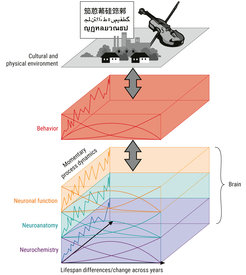
Adapted from Lindenberger, Li, & Bäckman (2006)
In attempts to explain the age-graded evolution of this system, maturation and senescence denote the operation of age-graded brain mechanisms and their effects on changes in behavior, which are especially pronounced early and late in life. In addition, learning, at any point during ontogeny, denotes changes in brain states induced by behavior–environment interactions. Maturation cannot take place without learning, and learning cannot take place without maturation. Similarly, the ways in which senescence takes its toll on the brains of aging individuals depends on their past and present learning and maturational histories. To complicate matters, processes commonly associated with maturation are not confined to early ontogeny, and processes related to senescence are not restricted to old and very old age. For instance, neurogenesis and synaptogenesis, which qualify as maturational mechanisms promoting plasticity, continue to exist in the adult and aging brain; conversely, declines in dopaminergic neuromodulation, which indicate senescence-related changes in brain chemistry, commence in early adulthood. Thus, maturation, senescence, and learning mutually enrich and constrain each other throughout the entire lifespan and must be understood and studied as interacting forces constituting and driving the brain–behavior–environment system. Psychologists occupy a central position in this endeavor because they possess a rich and adequate repertoire of experimental and methodological tools to describe and modify the organization of behavior. In particular, direct comparisons between children and older adults help to identify commonalities and differences in the mechanisms that drive child and adult development.
Proposition 2: Lifespan Theory and Methodology Need to Integrate Evidence Across Domains of Functioning, Timescales, and Levels of Analysis
Developmental psychology is faced with three challenging integrative tasks. First, there is the need to integrate theorizing and research practice across functional domains to attain a comprehensive picture of individual development. For instance, sensorimotor and cognitive functioning are more interdependent in early childhood and old age than during middle portions of the lifespan, and developmental changes in either domain are better understood if studied in conjunction. Similar observations can be made for many other domains of functioning whose changes have generally been studied in isolation, such as the ontogeny of social interaction and cognition; of emotion regulation and motivational states; or of memory, working memory, and attention.
Second, there is a need to understand the mechanisms that link short-term variations to long-term change. Short-term variations are often reversible and transient, whereas long-term changes are often cumulative, progressive, and permanent. Establishing links between short-term variations and long-term changes is of eminent heuristic value, as it helps to identify mechanisms that drive development in different directions. For instance, aging cognitive systems show a decrease in processing robustness, which may signal impending long-term changes in other characteristics of the system (see Figure 2). To articulate these different timescales, we need to gather multivariate time-series data that capture short-term variability and long-term changes in cross-domain dependencies.
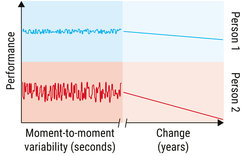
Figure 2. Illustration for predictions linking moment-to-moment variability to long-term change and brain changes to behavioral changes. Aging individuals with greater moment-to-moment fluctuations in behavior at a given point in time are expected to show greater subsequent longitudinal decline in mean levels of functioning than individuals who fluctuate less.
Third, to arrive at mechanistic explanations of behavioral change, there is the need to integrate behavioral and neural levels of analysis. At any given point in the lifespan, one-to-one mappings between brain states and behavioral states are the exception rather than the rule, as the brain generally explores and offers more than one implementation of an adaptive behavioral outcome (Lövdén, Garzón, & Lindenberger, 2020). Therefore, ontogenetic changes in behavioral repertoires are accompanied by continuous changes in multiple brain–behavior mappings. Some of these remapping gradients may be relatively universal and age-graded, whereas others may be more variable, reflecting genetic differences, person-specific learning histories, the path-dependent nature of developmental dynamics, or a combination of all three. The resulting picture underscores the diversity and malleability of the organization of brain and behavior as well as the constraints on diversity and malleability brought about by (a) universal age-graded mechanisms associated with maturation and senescence, (b) general laws of neural and behavioral organization, and (c) sociocultural as well as physical regularities of the environment.
Proposition 3: The Exploration of Age-Graded Differences in Plasticity Is a Powerful Tool for Identifying Mechanisms of Development
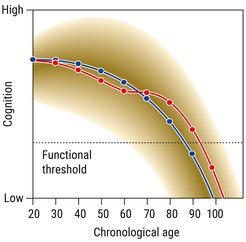
Figure 3. An individual’s range of possible cognitive developmental trajectories from early to late adulthood. The blue curve shows the most likely developmental path under normal circumstances. The fading of the background color indicates that more extreme paths are less likely. The functional threshold represents a level of functioning below which goal-directed action in the individual’s ecology will be severely compromised. The red curve represents the hope that changes in organism–environment interactions during adulthood move the individual onto a more positive trajectory. Beneficial changes may consist in the mitigation of risk factors, such as vascular conditions, metabolic syndrome, or chronic stress; the strengthening of enhancing factors, such as neuroplasticity, or both.
Both from scientific and societal perspectives, plasticity, or the alteration of developmental trajectories through experience, is a precious phenomenon. Scientifically, inquiries into the plasticity of brain and behavior are rich sources of developmental information. Through the assessment of “changes in change,” they offer the promise to observe the operation and proximal consequences of developmental mechanisms. For instance, studies in which research participants of different ages are instructed and trained to perform one or more cognitive tasks come with important validity benefits, such as (a) an increase in experimental control, (b) the identification of age differences near asymptotic performance levels, and (c) the assessment of transfer and maintenance effects. If neurochemical, neuroanatomical, and neurofunctional imaging measures are assessed before, during, and after training, intervention studies also offer new insights into relations between behavioral and neural manifestations of plasticity. By partly taking control over behavior–environment interactions, mechanisms of learning can be studied in the context of maturation and senescence.
From the larger perspective of societal evolution, cognitive intervention studies explore the range of possible development, or what could be possible in principle if conditions were different (see Figure 3). Hence, investigations of age changes in the plasticity of development carry the potential to explain and ameliorate the expression of human potential.
Key Reference
Collaboration Highlights
During the reporting period, the Center has continued to engage in long-term collaborations with scientists from other institutions. In the following, we highlight three examples.
The Strong Dependency Between Changes in Fluid and Crystallized Abilities Across the Adult Lifespan
Together with Elliot Tucker-Drob from the University of Texas at Austin, who received the Max Planck-Humboldt Medal for his contributions to lifespan psychology in 2019, we revisited the developmental scope of the distinction between crystallized and fluid cognitive abilities (Tucker-Drob et al., 2022). Theories of adult cognitive development classically distinguish between fluid abilities, which require effortful processing at the time of assessment, and crystallized abilities, which require the retrieval and application of knowledge. On average, fluid abilities decline throughout adulthood, whereas crystallized abilities show gains into old age. These diverging age trends have led to the proposition that individuals might compensate for fluid declines with crystallized gains. However, in two independent data sets, we found that rates of change were strongly correlated across fluid and crystallized abilities (see Figure 4). In other words, individuals showing greater losses in fluid abilities tend to show smaller gains, or even losses, in crystallized knowledge. This commonality in change limits the room for on compensation and directs attention toward domain-general drivers of adult cognitive decline and maintenance (Nyberg et al., 2022).
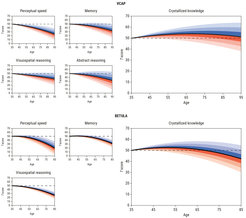
Figure 4. Changes in fluid and crystallized cognitive abilities strongly are linked across the adult lifespan. Trajectories of change over age in five cognitive abilities stratified across the distribution of variation in the general factor of change in fluid ability. The black curves represent the population average trajectories for each cognitive ability. Blue shading represents shallower-than-average rates of general fluid declines, whereas red shading represents steeper-than-average rates of general fluid declines. Each increment of shading corresponds to a 0.5 SD shift in the general factor of decline in fluid ability. More saturated colors correspond to more densely concentrated regions of the distribution of change. Changes in crystallized knowledge strongly covary with changes in fluid abilities. VCAP = Virginia Cognitive Aging Project; BETULA = Betula study.
Image: MPI for Human Development
Adapted from Tucker-Drob et al. (2022)
Original image licensed under CC BY-NC 4.0
The Role of Education in Adult Cognitive Development
Together with colleagues from the Lifebrain consortium, we examined the effects of education on cognitive aging. The number of years of formal education is known to correlate positively with cognitive function throughout adulthood, and to predict lower risk of dementia late in life. These observations have led to two separable propositions: first, that prolonging education enhances cognitive function, and second, that education attenuates aging-associated cognitive decline. Lövdén, Fratiglioni, et al. (2020) evaluated both propositions by reviewing the literature on educational attainment and cognitive aging. In agreement with the first proposition, there was clear evidence for a positive link between years of education and levels of cognitive functioning. However, contrary to the second proposition, associations between education and aging-associated cognitive decline were found to be negligible. Also, the observed association between educational attainment and late-life dementia risk could be accounted for by a threshold model of dementia, according to which individuals with lower levels of cognitive functioning early in life are more likely to hit the dementia threshold late in life. In line with these findings, Nyberg et al. (2021) observed that higher levels of education are not associated with slower rates of brain atrophy in the cortex and the hippocampus (see Figure 5). Finally, combining brain and behavioral levels of analysis, Lövdén et al. (2023) examined whether education protects against cognitive decline by providing a “cognitive reserve,” such that individuals with higher educational attainment show weaker associations between changes in brain and cognition than individuals with lower educational attainment. Contrary to this hypothesis, the data were plausible under the assumption that there is no influence of education on the strength of the association between change in episodic memory and change in hippocampus volume. Taken together, these findings support the view that educational attainment exerts its influences on late-life cognitive function primarily by contributing to individual differences in cognitive skills that emerge in early adulthood and persist into older age.
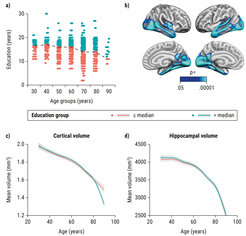
Figure 5. Educational attainment does not influence brain aging: Data from the Lifebrain project. (a) Marked individual differences in education in all age groups. (b) Cortical regions showing more volume loss with increasing age, i.e., nonlinear age changes (p < 0.05, corrected for multiple comparisons). (c) Education was not related to rate of change in the atrophy-prone cortical regions in b. (d) There was significant hippocampus volume loss but no influence of education on rate of change. Education groups in c and d are based on a median split, indicated by the dashed line in a and used for illustrative purposes. The shaded areas around the lines denote 95% CI.
Adapted from Nyberg et al. (2021)
Original image licensed under CC BY-NC-ND 4.0
Strengthening the Connections Between Lifespan Cognitive Neuroscience and Neurobiology
To foster a mechanistic understanding of changes in human behavior, there is a need to intensify research efforts that aim at closing the gap between human cognitive neuroscience and animal models. LIP is currently involved in three endeavors of this sort. First, in collaboration with the Lise Meitner Group for Environmental Neuroscience, the MPI for Biological Intelligence, and the MPI for Psychiatry, we seek to gain a more mechanistic understanding of human brain plasticity by carrying out coordinated experimental research with humans and mice (see Spotlight Magazine). Second, in collaboration with the laboratory of Tomás Ryan at Trinity College Dublin, we are in the process of establishing a coordinated research program on the ontogeny of memory engrams in rodents and humans (see RHYME). Third, as part of a research program led by Gerd Kempermann at Deutsches Zentrum für Neurodegenerative Erkrankungen (DZNE) Dresden, we continue to collaborate on the “individuality paradigm,” an automated longitudinal activity tracking of large cohorts of genetically identical mice in an enriched environment (Kempermann et al., 2022; see Figure 6). The goal of this paradigm is to study how development itself functions as a source of individual differences (Freund et al., 2013). All three collaborations are challenging, as they require conceptual reframing and experimental innovation on either side. However, the challenges are worth the effort, as they come with the prospect of fostering knowledge about developmental mechanisms in human development.

Figure 6. Studying the ontogeny of individuality in mice: the Individuality paradigm (“Colony Rack”). (a) 3D-representation of the cage design, showing the 70 standard type II cages on a double-sided rack. The cages are connected by plastic tubes. (b) The connector tubes are equipped with ring antennas (black rings) which collect the RFID signal from the individual transponders that the mice carry under the skin in their neck. Mice enter the tubing system through circular holes cut into the walls of the standard cages. (b) Tubes also connect the floor levels. The cages can be removed for cleaning. The tubes contain a removable plastic mesh that increases traction when the mice run up and down the steep slopes. (d) View into the tubing system with mice in action. Note that the version of the cage shown here had white ring antennas.
Adapted from Kempermann et al. (2022)
Original image licensed under CC BY-NC-ND 4.0
Key References
Research Awards (Selection)
In 2020, Beate Mühlroth was awarded the Becker-Carus 2020 doctoral prize of the German Sleep Society. In 2021, Martin Dahl received two awards for his dissertation, the Otto Hahn Medal of the Max Planck Society, and the Margret and Paul Baltes Award of the Developmental Psychology Section of the German Psychological Society (DGPs). Chi (Zoe) Ngo was awarded the Research Fellowship of the Jacobs Foundation. Amrisha Vaish, University of Virginia, Charlottesville, received the Max Planck Sabbatical Award 2021. In 2022, Tobias Grossmann, University of Virginia, Charlottesville, received the Alexander von Humboldt Foundation’s Friedrich Wilhelm Bessel Research Award. Julian Kosciessa received the Otto Hahn Medal of the Max Planck Society for his dissertation, as well as the Brain Products Young Scientist Award for outstanding contributions to EEG research, awarded by the German Society of Psychophysiology and its Application. In 2023, Ulman Lindenberger was elected Foreign Member of the Royal Swedish Academy of Sciences in the Class for Social Sciences.
Overview of Research Projects at the Center for Lifespan Psychology
In March 2023, empirical and conceptual work at the Center was structured into eight research projects (see Table 1). Since the reporting period 2017–2019/20, a new project, Lifespan Neuromodulation of Cognition (LINE) was formed in fall 2022 on the basis of prior work in the RHYME project. With the retirement of Viktor Müller, the Interactive Brains, Social Minds project will come to a close at the end of 2023. Furthermore, in light of the newly founded Max Planck Research Group MR Physics, the Brain Imaging Methods in Lifespan Psychology project will be dissolved and integrated into the new group in the course of 2023. Thus, by the end of this year, the number of projects will have decreased from eight to six.
The specific activities pursued in the various projects cover a wide array of research areas in human behavioral development. For example, the following questions have been addressed during the reporting period: (a) How can we support Open Science practices with a unified workflow that guarantees reproducibility of both statistical analyses and resulting publications (Peikert & Brandmaier, 2021)? (b) How does the coupling between slow oscillations and spindles during sleep, which acts as a key electrophysiological mechanism supporting memory consolidation, differ between children, adolescents, and adults? (c) Does the precision of the interaction between oscillatory activity in theta and gamma frequency bands during the encoding of object–context associations differ between younger and older adults, and do these differences matter for later retrieval of contextual information (Karlsson et al., 2022)? (d) How does deterioration of the locus coeruleus, a small nucleus in the brainstem, and the brain’s main source of the neuromodulator noradrenaline, contribute to normal cognitive aging and late-life dementia (Dahl, Bachman, et al., 2023)? (e) What are the structural and functional brain changes in aspiring professional musicians who are preparing for an entrance exam at a university of the arts (Wenger et al., 2021)? We provide our current answers to these questions and many more on the following pages.
Table 1. The Center for Lifespan Psychology at the Max Planck Institute for Human Development: Overview of Research Projects
| Name of Project | Researchers, Including Postdoctoral Fellows | Predoctoral Research Fellows |
|---|---|---|
| Lifespan Rhythms of Memory and Cognition (RHYME) | Markus Werkle-Bergner**; Ann-Kathrin Jöchner*, Ulman Lindenberger, Chi (Zoe) Ngo*, Sarah Power* | Elisa S. Buchberger |
| Lifespan Age Differences in Memory Representations (LIME) | Myriam C. Sander 1 **; Ulman Lindenberger | Claire Pauley |
| Lifespan Neuromodulation of Cognition (LINE) | Martin J. Dahl**; Ulman Lindenberger | Agnieszka Kulesza |
| The Berlin Aging Studies (BASE & BASE-II) | Julia A. M. Delius**, Ulman Lindenberger**; Andreas Brandmaier, Gert G. Wagner 2 | |
| Mechanisms and Sequential Progression of Plasticity | Elisabeth Wenger**; Yana Fandakova°, Ulman Lindenberger, André Werner | Maike Hille, Neda Khosravani, Eleftheria Papadaki, Sina A. Schwarze |
| Formal Methods in Lifespan Psychology | Andreas M. Brandmaier**, Ulman Lindenberger, Timo von Oertzen°, Aaron Peikert | Hannes Diemerling° |
| Interactive Brains, Social Minds | Viktor Müller**; Ulman Lindenberger | |
| Brain Imaging Methods in Lifespan Psychology | Nils C. Bodammer**; Ulman Lindenberger, Naftali Raz, Davide Santoro | |
Lifespan Neural Dynamics Group (LNDG) | Douglas D. Garrett** | Fabian Kamp, Zoya Mooraj, Liliana Polanski, Alexander Skowron |
Notes. The table refers to projects and project members as of March 31, 2023; for updates, visit the LIP website. LNDG is an independent research group that closely collaborates with LIP.
**Principal investigator; *Postdoctoral fellow; °Primary affiliation with another institution.
1 Myriam C. Sander leads a Minerva Research Group.
2 Gert G. Wagner is Max Planck Fellow at the MPI for Human Development.





